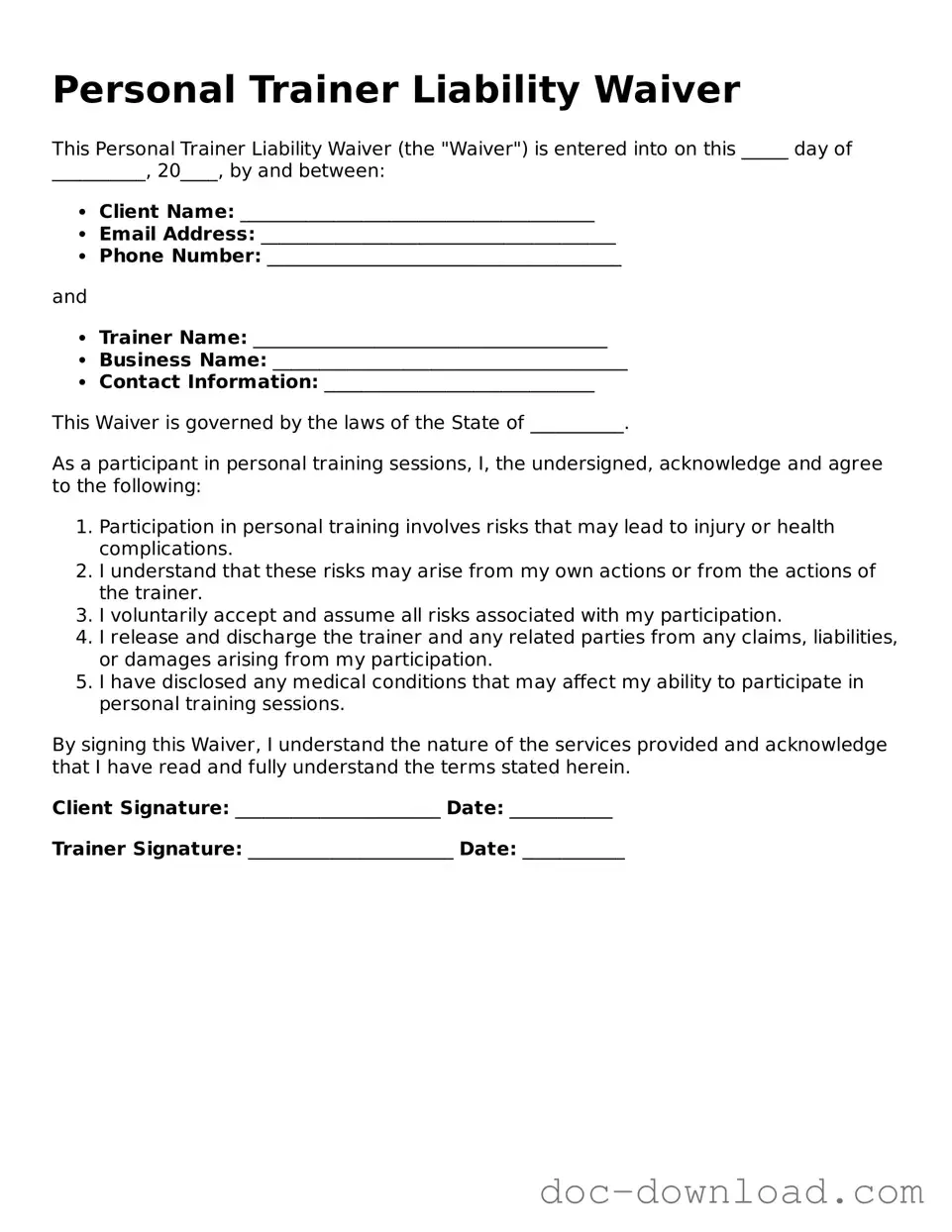The Personal Trainer Liability Waiver form shares similarities with the General Liability Waiver. Both documents aim to protect service providers from legal claims arising from accidents or injuries that may occur during the provision of services. In the case of the General Liability Waiver, it applies broadly to various services, ensuring that clients acknowledge the inherent risks involved and agree to release the provider from liability. This mutual understanding fosters a safer environment for both parties, emphasizing the importance of informed consent.
Another document comparable to the Personal Trainer Liability Waiver is the Sports Participation Waiver. This waiver is commonly used in organized sports settings, where participants acknowledge the risks associated with physical activities. Like the Personal Trainer Liability Waiver, it requires participants to accept responsibility for their own safety and to understand that injuries can occur despite precautions. The key similarity lies in the focus on informed consent and the release of liability for organizers or coaches.
The Release of Liability form is also akin to the Personal Trainer Liability Waiver. This document is often utilized in various recreational activities, such as adventure sports or fitness classes. It serves to inform participants of potential risks and to obtain their agreement to waive claims against the provider. Both waivers emphasize the importance of personal responsibility and the understanding that engaging in physical activities carries inherent risks.
The Medical Release Form bears resemblance to the Personal Trainer Liability Waiver in that it also requires participants to acknowledge their health status before engaging in physical activities. This document often requests information about pre-existing conditions and grants trainers permission to seek medical attention if necessary. While it focuses more on health disclosures, both forms serve to protect the trainer and ensure that clients are aware of their own physical limitations.
A crucial aspect of ensuring smooth operations and safety in both service industries and personal activities is the careful management of liability through various forms, including waivers and agreements. Understanding these documents can significantly benefit both providers and participants. For instance, the FedEx Release Form is designed to authorize FedEx to deliver packages in your absence, providing peace of mind when you cannot be present to receive your shipment. For further information about the FedEx Release Form, visit topformsonline.com/fedex-release/.
Similarly, the Assumption of Risk Agreement is another document that aligns with the Personal Trainer Liability Waiver. This agreement is often used in extreme sports or activities with higher risk factors. Participants explicitly acknowledge the risks involved and agree to take full responsibility for any injuries that may arise. Both documents aim to clarify the understanding of risks and limit liability for the service provider.
The Consent to Treat form is also relevant, as it is used in health and fitness settings to ensure clients understand the nature of the services they will receive. This document often includes information about the types of treatments or exercises that will be performed. While it focuses on consent for treatment, it shares the underlying principle of informed consent found in the Personal Trainer Liability Waiver.
The Fitness Class Waiver is another document that parallels the Personal Trainer Liability Waiver. This waiver is typically used in group fitness settings, where participants acknowledge the risks associated with group exercise. Like the Personal Trainer Liability Waiver, it emphasizes the importance of understanding potential hazards and agreeing to release the provider from liability for any injuries sustained during the class.
Lastly, the Adventure Activity Waiver is similar in nature to the Personal Trainer Liability Waiver. This document is often required for activities such as rock climbing, zip-lining, or other adventure sports. Participants must acknowledge the risks involved and agree not to hold the organizers liable for any injuries. Both waivers serve to inform participants of potential dangers and promote a clear understanding of personal responsibility in high-risk situations.
